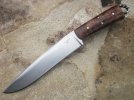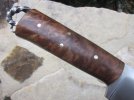I like forging but personally have found it to be more useful for making fittings and tooling than for making blades. This is based on both the types of knives I make, and my forging skills, or lack thereof. If I made a lot of curved blades, or had a more free-form style, forging would make a lot more sense for me. If I were better with a hammer, that might change the picture somewhat as well. If I were bent on making my own damascus, it would obviously be a major priority.
For making blades of the more common variety, however, or for achieving a specific design, I find that stock removal is inherently more accurate than forging, and a bandsaw and a 2hp grinder to be more than a match for my arm and a 3lb hammer for speed. Straightening a forged blade is a skill in and of itself and can be a time consuming process that, for me at least, more or less negates any time that forging might save over grinding to shape.
Having said that, it can be marvelously useful for certain things, and it is a lot of fun in it's own right, whether you are making a blade or a guard or a pair of tongs. The flowing tapers and organic curves that forging lends itself to seem intuitive rather than calculated, which is not easy to achieve when your mind is forced to work within rectangular dimensions. Not to mention how hard it would be to do a twist by stock removal-that particular feature belongs to smiths almost exclusively (casting is cheating).







